Trio of talented pitchers provide hope for Padres in farm system
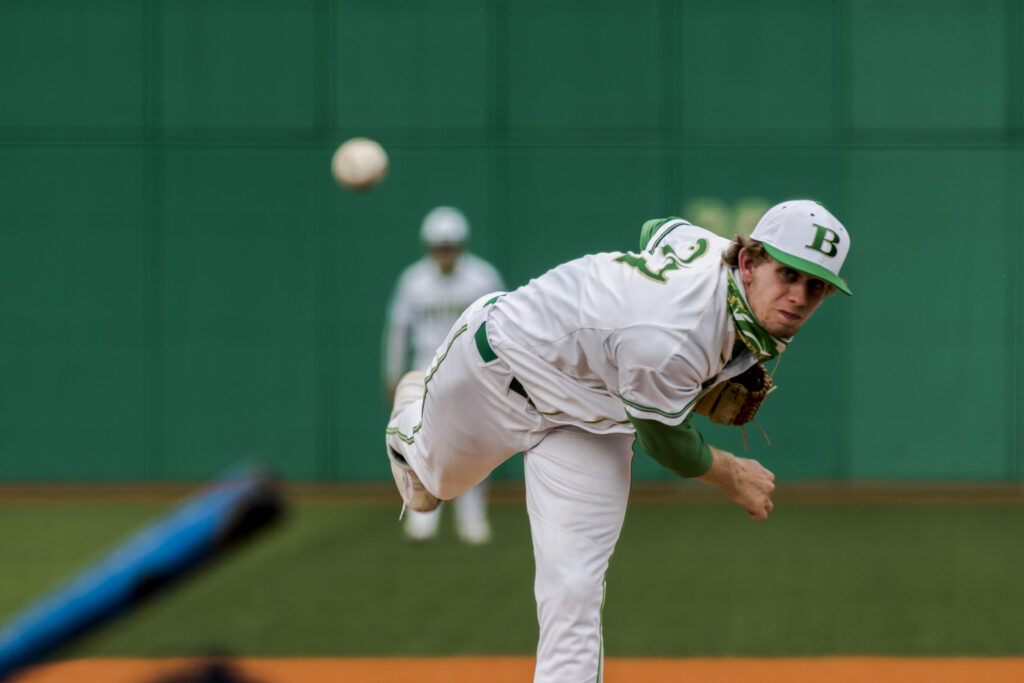
Credit: Baseball America
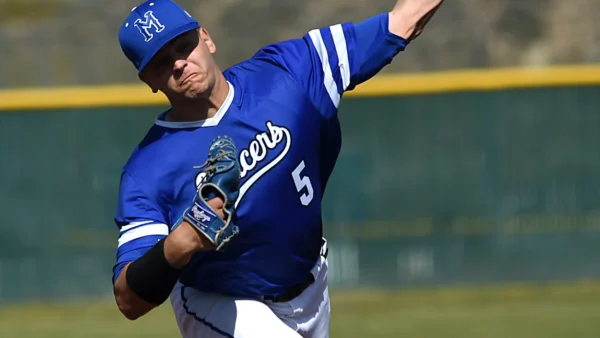
Typically known for their minor league depth and a star-studded farm system, the San Diego Padres find themselves in an unfamiliar spot under A.J. Preller.
The Padres have consistently traded away pieces from their once prized system over the years, most recently sending a quartet of young, talented names for superstar Juan Soto.
While the Soto deal is certainly something you do in a heartbeat, the state of the Padres’ organizational depth does raise some questions for their future outlook. They’re obviously in win-now mode, but stocking up the farm has to be towards the top of Preller’s to-do list.
That shouldn’t be an issue for the man in charge of San Diego’s baseball operations. Preller’s widely respected as a top-tier scout across the baseball industry, and some may even go as far as calling him the game’s best pure scout. He’s a genius at identifying talent on the amateur side and has dominated the international realm, whether it’s the Latin market or overseas.
San Diego’s first step to retooling its farm system came in July from the annual MLB amateur draft.
The Padres held three picks inside the top 55 of the draft, including two on the draft’s first day. Preller used his first three selections on pitchers, all of which have considerable upside and offer plenty of intrigue in their own right.
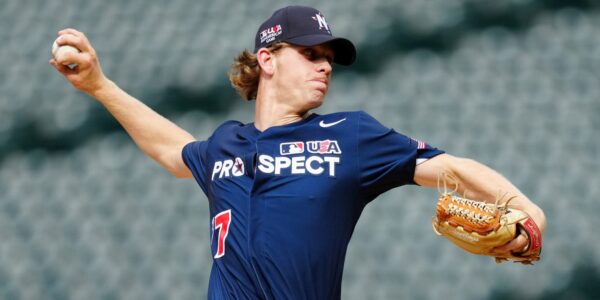
First off the board was Dylan Lesko, who the Padres drafted at 15th overall and signed for a slightly under-slot value of $3.9 million.
Before undergoing Tommy John surgery early in his senior year, Lesko had a real chance to hear his name called toward the top of this draft. He earned National Gatorade Player of the Year honors as a junior in 2021, an uncommon feat, and several have regarded him as the premier prep pitching prospect of the last few years.
Lesko’s blend of polish and upside are advanced beyond his years. His athleticism and silky-smooth downhill patterns are clear, and he’s able to produce easy low-to-mid-90s velocity with his fastball from a clean, loose arm path.
Lesko’s go-to secondary is a soul-stealing changeup that was largely touted as the best such pitch in this draft class. He throws it with confidence, and it mimics his fastball’s plane, making it that much more difficult for opposing hitters to pick up. Though his breaking ball is his least reliable offering, Lesko flashed an improved ability to utilize it around the zone before his injury, and it’s a pitch that’s always produced high raw spin.
Buford (Ga.) RHP Dylan Lesko got 12 swings and misses tonight. Here they are, organized by pitch type. #MLBDraft pic.twitter.com/JgqG3RkKnY
— Josh Norris (@jnorris427) April 7, 2022
Selecting and signing a high school right-handed pitcher early is always risky, especially when you pay that prospect nearly $4 million. With that said, Lesko likely wouldn’t have been available had he not gotten injured, and his ceiling could be one of the game’s best pitching prospects down the road.
The Padres’ next selection came in the competitive balance round, where they plucked high school left-handed Robby Snelling at pick No. 39 overall from Nevada.
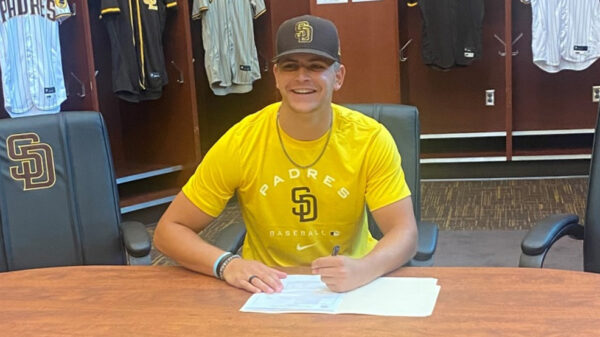
Snelling was a serious two-sport recruit in high school. He was headed to Arizona on a baseball/football commitment before flipping to Louisiana State late in his recruiting cycle. He dominated this past spring for his high school squad, punching out 145 batters in 62 ⅓ innings and a 0.56 ERA. Snelling’s upside is undeniable, and it was likely the reason why San Diego felt comfortable signing him for $3 million, roughly $1 million over the draft’s slot value.
Built physically and like a quarterback, at 6-foot-3, 210-pounds, Snelling produces low-to-mid-90s from the left side of the rubber, running his heater up into the 96-97 mph range at best. Aside from his velocity, Snelling controls the arm side of the plate with that fastball and works from a fast, slightly deceptive arm stroke.
Snelling’s ability to spin a breaking ball is his golden touch, and he’ll rip off an upper-70s hook that regularly shows swing-and-miss spin. It’ll be his carrying tool through the professional ranks and a staple within his arsenal should he have success at the major league level. His aptitude to straight-up spin and the way his arm works could lead to a more firm laterally spun slider developing down the road, too. Albeit both loud, Snelling’s work on the mound consists of only two pitches, and the development of his changeup moving forward may be the key to fully unlocking his potential.
Popped up to Anaheim to see LHP Robby Snelling. Physical athlete, working quickly and cruising. 8 Ks through 3 IP. Sitting 88-91. 75-79 breaking ball. @LSUbaseball recruit.@PBR_Nevada | @prepbaseball | @ShooterHunt | #mlbdraft pic.twitter.com/hEfaGSgOjd
— Nathan Rode (@NathanRode) March 23, 2022
Preller’s fond of selecting left-handed pitching prospects early in the draft – see Eric Lauer, Joey Lucchesi, MacKenzie Gore, and Ryan Weathers. Snelling checks an abundance of boxes, and this is the type of prospect the Padres love taking shots on.
Concluding this trio is Adam Mazur, who hails from the collegiate ranks and perennial Big 10 contender Iowa. The Hawkeye’s former pitching coach, Robin Lund, was recently hired by the Detroit Tigers after producing a few name-to-know pitching prospects in his time there.
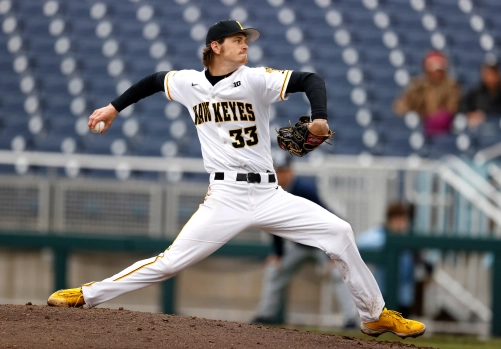
Mazur’s track record in college was rather interesting. He started at South Dakota State and struggled for the Jackrabbits, pitching to a 5.50 ERA in his first two seasons. Then, Mazur shined at the Cape Cod collegiate league, punching out 34 batters with a 1.55 ERA across 29 innings of work. Mazur transferred to Iowa with plenty of buzz behind him after the summer, and many had him penciled in the first round early on in last year’s draft cycle.
Some of that momentum carried over to the Hawkeyes for Mazur, who captured the conference’s ‘Pitcher of the Year honors last season. Mazur punched out roughly a batter per inning and cut his BB/9 down considerably from 4.1 in 2021 to 2.9.
Mazur’s arsenal is loud, and it all starts with a weaponized slider that he spins in the mid-to-high-80s with late biting action. It’s a pitch that he uses to generate plenty of whiffs, and it’s shown capable of missing bats at the big league level. Mazur throws a four-seam fastball in the mid-to-high-90s with flatter action, and he’ll sink a two-seamer in the low-90s, too.
Mazur features a changeup and curveball too, but both are fringe-average pitches, though the former could be an effective change-of-pace pitch at the next level.
Iowa RHP Adam Mazur has been a revelation this season. Was 91-95 on the Cape. He’s been 93-96 this year, touching 97. Slider is mid-80s w/sharp sweep and plus command. Flashes a big CB + a CH. Running a 42% whiff% right now on 69.2% strikes.
13.2 IP, 18 K, 2 BB, 4 H, 1 ER.
📈📈 pic.twitter.com/TJrm4lX9Jz— Joe Doyle (@JoeDoyleMiLB) February 28, 2022
There’s undoubtedly reliever risk to Mazur, and the reason he didn’t go high in a draft that didn’t have many talented college arms was because of legit control concerns. If he can build off what he started this past year, however, the Padres may have a steal on their hands.
[wpedon id=”49075″ align=”right”]
These three prospects already slot toward the top of the Padres’ organizational chart.
They will be the stepping stone in this team’s quest to build back up their farm system, and all three are talented enough to don the brown and gold someday in the future.
Diego works at Prep Baseball Report as an Area Scout in Illinois and Missouri. He graduated this spring with a Bachelor Degree in Communications and played four years of college baseball, logging nearly 50 innings of work in a relief role. Diego hopes to work in an MLB front office one day and has been a Padres fan since he was six years old.